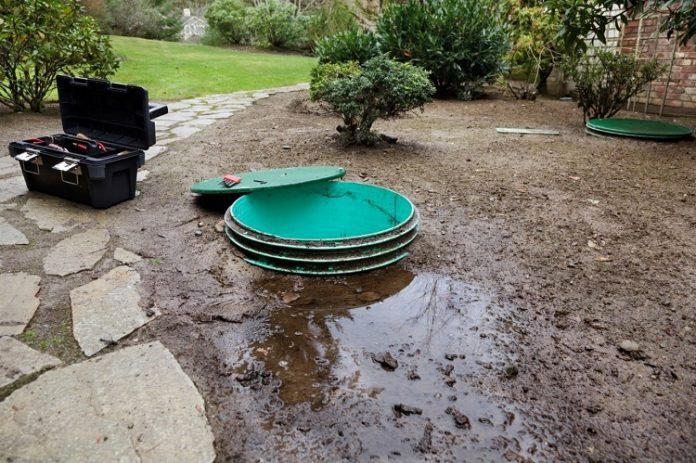Last Updated on August 15, 2023 by
Nobody wants to have to deal with septic tank problems. As a septic tank is made to dispose of wastewater from your shower, sink, and toilet, encountering any issues with this process is always less than pleasant.
If you’re not a professional plumber, there’s a good chance you won’t know when your septic tank is having problems unless you are aware of what signs to look for. Catching problems early on can help you avoid having to repair costly damage.
We’ve compiled a list of the most common septic tank problems, so keep reading below and stay ahead of the game.
Table of Contents
How a Septic Tank Works
To better diagnose specific issues, it’s best first to understand how a septic tank works. A septic tank’s job is to process and separate waste.
When waste flows into the tank, heavy solids settle on the bottom, which forms a sludge. Oils, greases, and lighter solids rise to the top, creating a layer of scum. Between these two layers is a layer of liquid that can flow through the outlet pipe to the drainage system.
In the tank, there are micro-organisms that feed on the sludge and scum layers, breaking down their volume, which creates various gases that escape through a vent.
When anything inhibits the process of breaking down these layers, you’ll have septic tank problems. Let’s discover the most common below.
1. Clogs
While having a clog in your home septic system may seem like a huge issue, it’s much more common than you may think.
Before jumping to this conclusion, you should consider when you had your septic tank pumped out last. As explained before, your septic tank collects solid waste and can store solid waste for three to 12 years.
If you haven’t pumped out your septic tank within the last two to three years, you could have a build-up of solid waste. You may experience sewage backups in your toilets and slow draining from your showers and sinks if this occurs.
If you have pumped out your septic tank semi-recently, you most likely have a clog somewhere between your house and the septic tank or in one of the drainage pipes that branch off.
To diagnose this problem correctly, you’ll need to find where the clog is located. If all of your drains are draining slowly, it’s likely the clog is in the pipe leading away from the house. It is possible a clog can be caused by items that were flushed down a toilet that shouldn’t have been, such as condoms, wet wipes, paper towels, and tampons.
If you’re experiencing a sewage backup in your home or surrounding the surface of your tank, it may be the outlet baffle or effluent filter. If you have access to it, check the inlet baffle, which will reveal a clog if there is one.
If you’re able to diagnose your problem, or even if you aren’t, consider calling the professionals like this company to solve these septic tank issues for you.
2. Tree Roots
Tree roots are very resilient, and when they infiltrate an area, anything in their way will be infiltrated too. This includes your residential septic system. They can cause your drain pipes to crack, which can widen and turn into an even more severe issue.
If you’re experiencing sewage backing up in your drains, mysterious cracks appearing on your sidewalk and driveway, and puddles and wet patches in your yard when it hasn’t rained, it’s likely you’re dealing with a problem of tree roots.
To avoid this issue, you can install specific pipes that can withstand the pressure of tree roots. When planting new trees or plants, make sure to note where all of your pipes are in your yard ahead of time.
One of the most efficient ways to solve this issue is to part ways with the trees whose roots are causing your problems. If you’re able to do this, make sure to remove the stumps of trees to avoid having the roots grow back.
3. Tank or Line Leak
If you suspect your yard is unnaturally green, such as if your grass is green, but all of your vegetation is dead, or all of your neighbor’s lawns are dead, you may have a tank or line leak.
Unnaturally green grass can signify that there is too much water being sent by your septic tank through your lateral lines, which is saturating your yard. This also means there might be sewage pooling in your yard, which is a danger to the environment.
When this occurs, it’s best to call the professionals immediately to avoid any permanent damage.
4. Incorrect Installation
Your septic tank needs to be installed properly for it to work properly. If you bought the house after the tank was installed, you won’t know who installed the system, which means you won’t know if it was done correctly.
If it is not sealed right, groundwater can leak into your tank, which will interrupt the process of breaking down the solid waste.
Other issues include the tank not being buried deep enough or installing the wrong sized tank. All of these can lead to septic tank failure, but you won’t be able to diagnose it unless you have access to it. It’s best to leave this to the professionals.
Use This Guide to Identify Septic Tank Problems
While dealing with septic tank problems is not ideal, understanding how a septic tank works and knowing the common issues can help you avoid significant damages and costs in the long term.
Be aware of how your toilets, showers, and sinks act, and keep an eye on your yard and driveway. If you notice any of the above problems or signs, contact your local plumber immediately.
In the meantime, why not learn a little something else today? We have tons of home and garden articles on our website, so go check them out!
Apart from that, if you are interested to know about Septic Tank Pumping then visit our Home Improvement category.



























